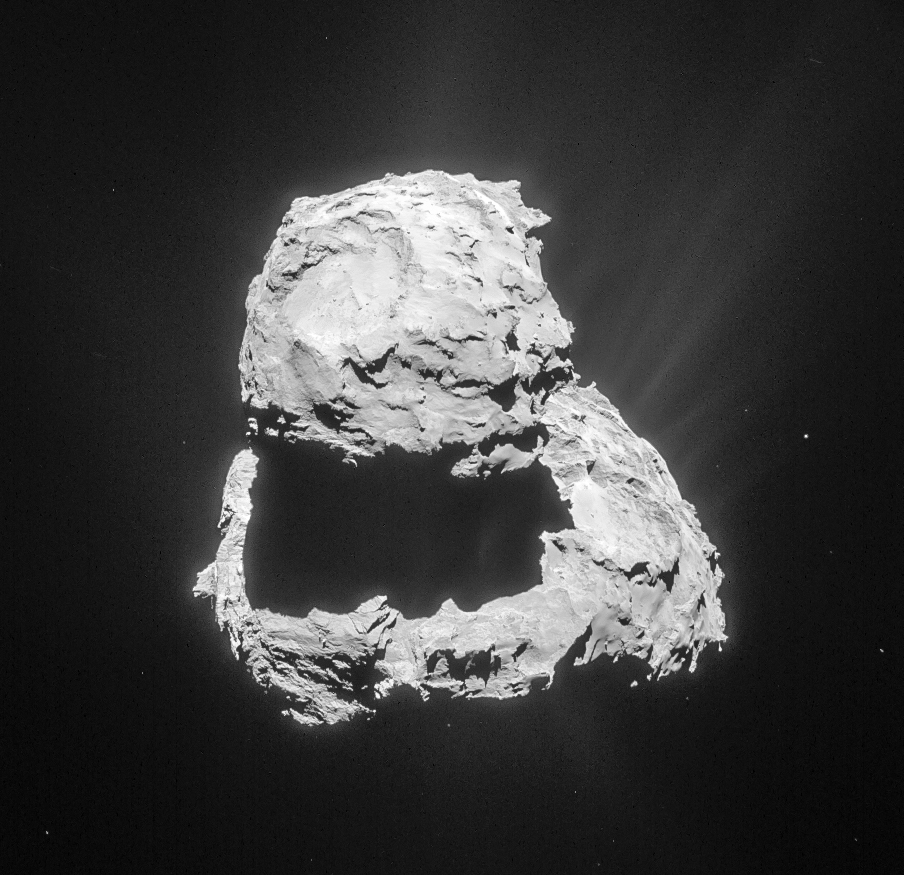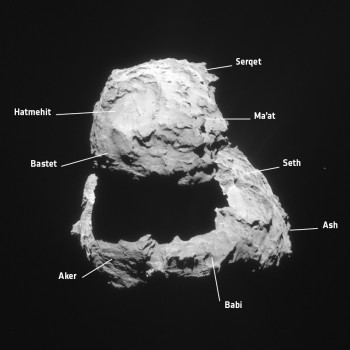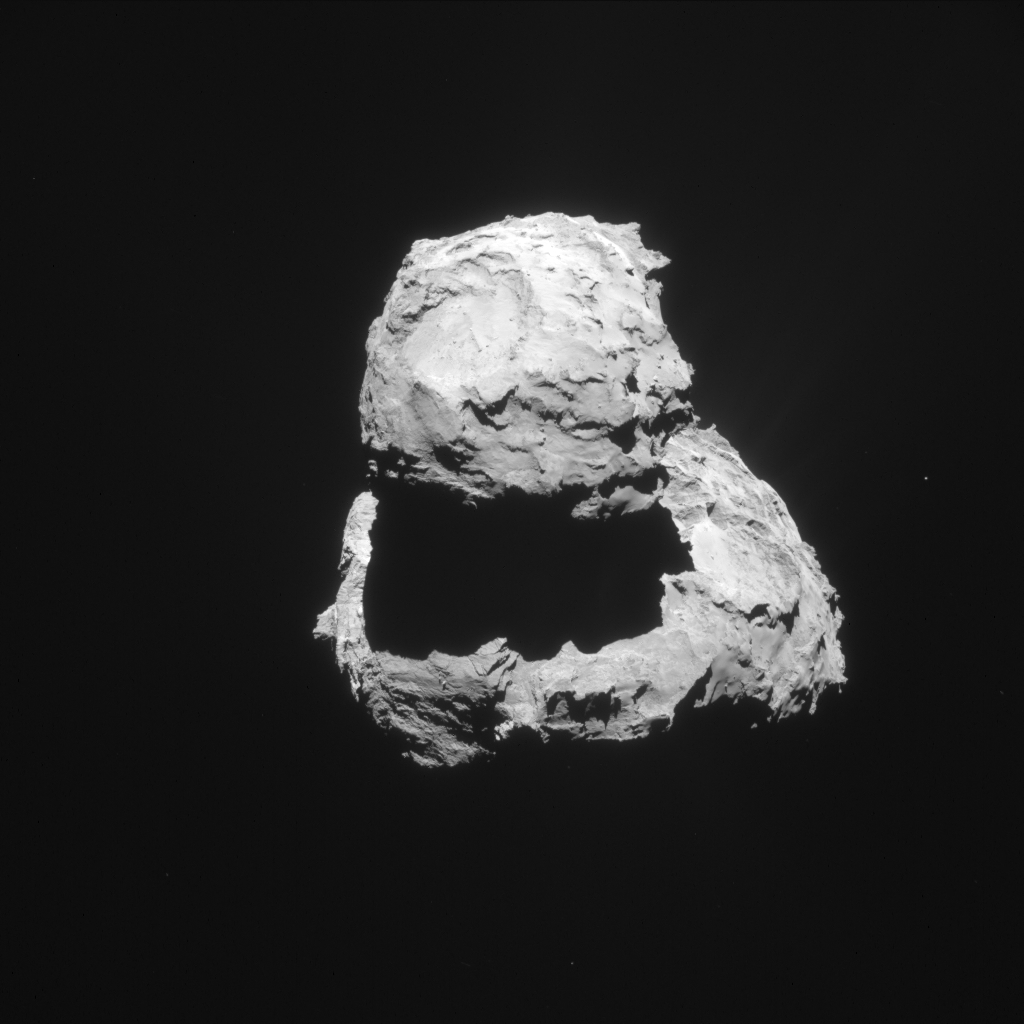This single frame NAVCAM image was taken on 18 March at a distance of 81.4 km from the centre of Comet 67P/Churyumov-Gerasimenko.
The image scale of the original 1024 x 1024 pixel image is 6.9 m/pixel and the image measures 7.1 km across; a cropped, processed version is shown below.

Cropped and processed single frame NAVCAM image of Comet 67P/C-G taken on 18 March 2015 from a distance of 81.4 km to the comet centre. This cropped version measures about 6.2 km across. Credits: ESA/Rosetta/NAVCAM – CC BY-SA IGO 3.0
 The image is processed to bring out the outflowing material while not overexposing the nucleus too much. Indeed, in this image, a few faint but distinct jets of material can be seen rising above the comet’s larger lobe, with a diffuse nebulosity visible around the entire nucleus.
The image is processed to bring out the outflowing material while not overexposing the nucleus too much. Indeed, in this image, a few faint but distinct jets of material can be seen rising above the comet’s larger lobe, with a diffuse nebulosity visible around the entire nucleus.
A labelled image is also provided to point out some of the regions on the comet’s surface. In this orientation we can see portions of the larger lobe emerging from the shadows – in particular parts of Aker and Babi – that in many previous images have been obscured by shadows cast by the comet’s smaller lobe.
The original 1024 x 1024 pixel image is provided below:










Discussion: 11 comments
So, the first picture to show the south pole illuminated from the Bastet/Aker side reveals the head lobe perimeter and body lobe perimeter turning in lock step with each other, as predicted here two months ago:
https://scute1133site.wordpress.com/2015/01/22/67pchuryumov-gerasimenko-a-single-body-thats-been-stretched-part-11/
Along with the usual display of matches between head and body but new ones in this case: Bastet to Aker and Ma’at to Babi, not simply correlated across the lobes but correlated by almost identical aggregated distances along the two separate perimeters.
Agree with the profile locking, A. Cooper.
Would it be possible to add the probable landing and hiding site for Philae to your excellent labelled images?
Hi Hamish, please refer to these images for the probable landing site: https://www.esa.int/spaceinimages/Images/2015/01/Lander_search_area
and
https://blogs.esa.int/rosetta/files/2014/11/ESA_Rosetta_Philae_CONSERT_landingsiteestimate.jpeg
I can’t click through to the full sized original image. Can this be fixed please?
Apologies – fixed!
Another beautiful image of 67P! I note this image has not been overexposed to preserve nucleus detail.
Given that, I would be interested in an update from the VIRTIS team regarding albedo. It was previously reported (Capaccioni et al, 2015) that 67P exhibits an albedo of 0.060 +/- 0.003 at 550 nm. As cometary activity increases, has the overturning and ejection of dust changed this value? If so, to what extent? Is there still a localized albedo identity (ref. reflectance spectra graph, Figure 1)? A changing albedo would be indicative of an evolving (i.e., heterogeneous) surface composition.
As I am new to this community, I am not sure if directing a question at a specific instrument team will necessarily yield a response. I would like to try again if I may …
My original question (above) relates to the abstract of a journal article that I am unable to access at the moment. According to the abstract, Schulz et al (Nature, 2015) states that dust production doubled between 2.7 and 2.5 AU. This kind of event should result in a change of albedo as the dust mantle covering the nucleus is shed. Has OSIRIS noticed a change as well, and is this change the motivation for their recent blog entry (“OSIRIS detects hints of ice in comet’s neck”)?
Thanks in advance!
Hi Booth. One of main purposes of ESA blogs is to present the thrill of discovery as it is happening. Live! Many questions we are asking here are also their’s. If well Out-reach can at some times break the ‘yellow band’ and ask some quick question, that’s far from custom.
We are fortunate enough as to have Space scientists on the Out-reach Team, and some resident contributors with scientific background. More than once in a time some member of the Teams drop-by and bring amiable guide.
……………..
As you, many of us think albedo has changed, but is my personal speculation that solid material could in general be darker than dry, surface particulate. The surface is being ‘swept’, no doubt about it, anyway.
I think, the situation is a little more complex, since in addition to the removal of the dust layer, there are also indications of transient ice:
https://www.hou.usra.edu/meetings/lpsc2015/pdf/2021.pdf
I’d interprete this as frost by resublimation.
The Rosetta team is currently very busy with collecting the maximum possible science data during this once-in-a-lifetime opportunity.
So there isn’t probably too much time for data reduction, detailed analysis, and preparing results for press.releases.
Priorities are on obtaining information for subsequent mission planning.